DESIGN PORTFOLIO
The Tale of The Dom Worker’s Moksha Objects - Entities - Meanings
Location: Manikarnika Ghats of Varanasi (India)
2022/2023


Creation of Meaning
The Social Construction of Death
Death, the only certainty and perhaps the most defining moment of our lives as living beings bring us the greatest uncertainty of what it is. The world is an amalgamation of entities and systems; each possessing a form of materiality or phenomenological presence. Including us as social beings, there is no entity that is in isolation regardless of its “autonomous-ity”, inanimate or not, where both tangible and intangible meanings can be drawn. Death as the Inter-Object exists and is inevitable to all of us. The relevance of the Inter-Object addresses our methodology toward understanding and acceptance of The SocialConstruction of Death (Brussel and Nico 2014). Here we dissect the entities involved in the ‘reality’ of death as fragments that resolves themselves into a perceived ideology. We can begin to understand Death as an Assemblage (Hayles 2019) of entities in constant negotiation (Bonsu 2001) that results in a manifestation of livelihood and social hierarchy (Pearson 2003).

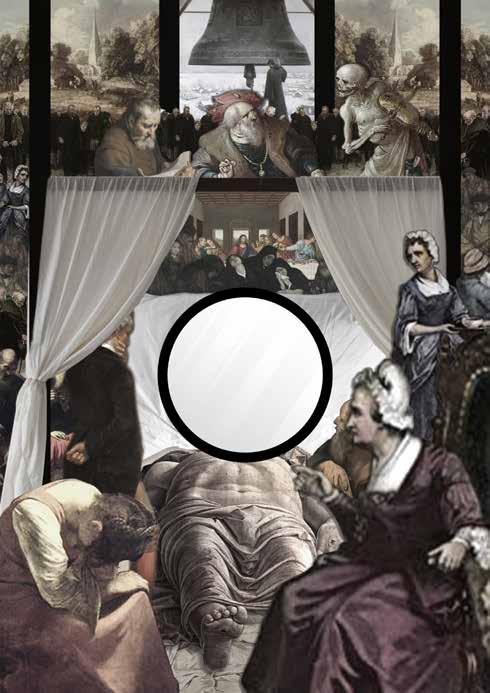
Pre-Premise - Death as an “Inter - Object” 1. 2. 3. The Distance and Meaning Fragments & Construction (i) Mirror of Meaning 1. 2. 3.

1.
I am the Servant of Death
Curse Liberators of Varanasi
“One cannot enter the gates of heaven if their bodies are cremated without the presence of a Dom. But people only respect us when it’s time for death, so we have made a life, living amongst the dead”, said Devi, a Dom worker of the Manikarnika Ghat (Shankar 2017). The Dom Workers of Manikarnika are a group of individuals in the Caste of the Untouchables, they are cursed by Lord Shiva in the Hindu faith to be responsible for the cremation of corpse, in order to provide ‘Moksha’ (liberation) to their souls. As such they engage in a series of rituals, clothing the corpse, washing the corpse, burning, and disposing of ashes. They are also responsible for the provision of the materials required in the above rituals. Being handlers of death, they are the outcast of society.
1.
2.
3.
4.
5.

Photograph by Michael Huniewicz
Photograph by Michael Huniewicz
Photograph by Michael Huniewicz
Photograph by Rohit Bhakar
Photograph by Andrea de Franci
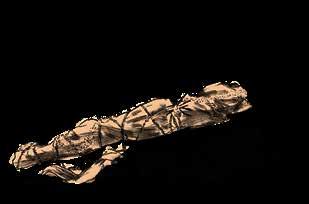



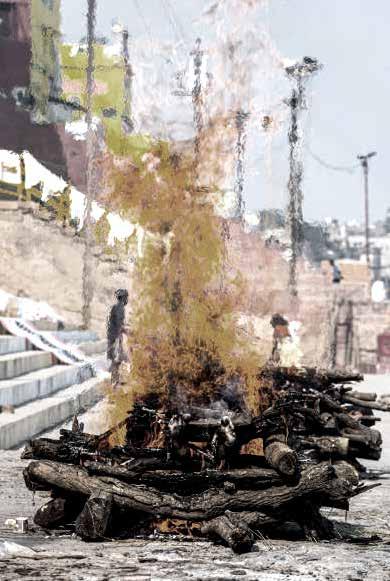
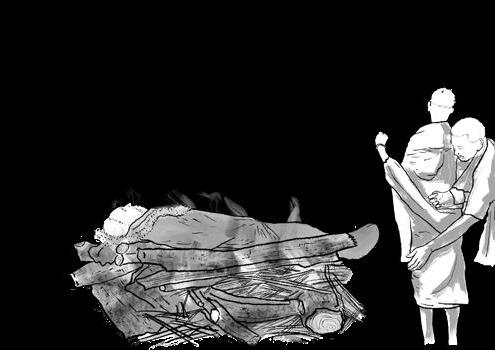

 2. Orange Cloth Drapped Over Corpse
3. Washing the Corpse in River Ganga
4. Cremating the Corpse
2. Orange Cloth Drapped Over Corpse
3. Washing the Corpse in River Ganga
4. Cremating the Corpse
Premise - The Dom Workers of Varanasi
5. Production, Storing and Sales of Wood Fuel



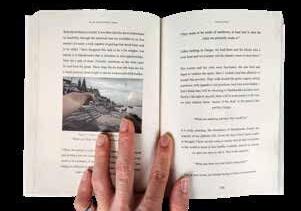
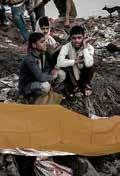









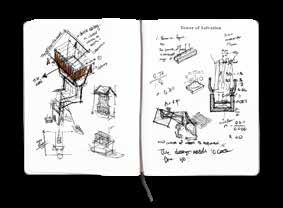
Photographs of Site (cited in book)
Cards to Organize Materials
Design Sketches by Author
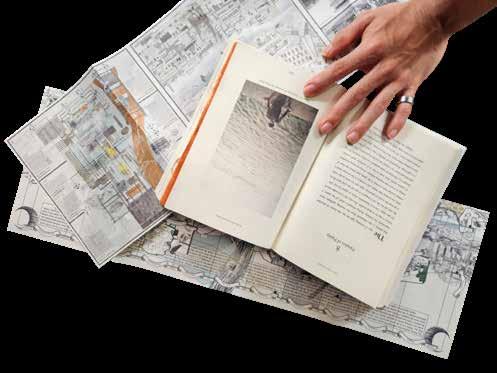
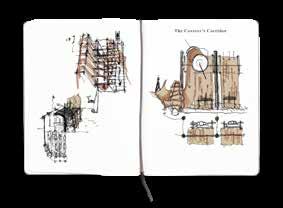

Reports and Interviews (cited in book)
Philosophy of Death by Author
Models to experience materiality by author



Research Materials
Embracing and Expressing of Study
The project acknowledges the inaccessibility to the real life experience of these forsaken individuals, hence it was necessary for the author to embrace a multiplicity of mediums and resources to empathize with them.
The expression of the gathered information also seeks to take the perspective of the Dom Workers and hence the embracing of their lives is of great criticality. The project begins its research by narrative a story of a Dom Worker based on reports and accounts, and this story’s timeline becomes the backbone of the thesis where the design takes life in the project.
The style of sketching, allegorical drawing language and even choice of model making materials are all made with the intention to support that single narrative of portraying the life of a Dom Worker.
Premise - Multiplicity in Methodology 1. 2. 3. 4. 5. 6. 7.
3. 4.
1. 2.
5. 6. 7. Story Book by Author

1.
“I
was only 7 years Old”
Understanding the Servants of Death
The job of the Dom Workers is handed down through birth due to the caste system. Born into this curse, they are expected to carry out the jobs of their predecessors without question. With little to no opportunity to education, the Dom Workers are unable to find an escape of this cyclical misery. The understanding of their suffering is done through the stitching of a series of interviews conducted by an array of sources, showing key moments of their lives and rituals that they conduct. It also emphasis on the emotions that are commonly expressed, the unhappiness and dissatisfaction with their ungodly position in the world. The Survey (2) suggest the lack of opportunity for Dom Workers to self-education & improve their economic situation without assistance.



2. Socio-economic Survey only completed 90 Dom Workers due to lack of education

3.
1.
2.
Socio-economical Report
3. “I was only 7 Years Old” by Author
4. 5.
Notes from the Untouchables by Author
Existing Cremation Pyre

4.
5.
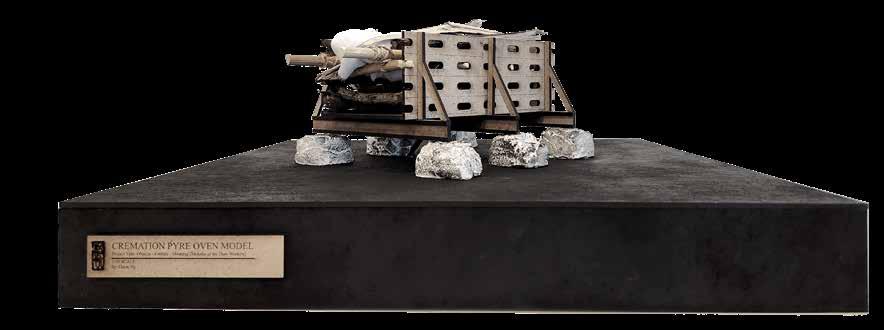

Premise - Dom Workers of Varanasi (India)
Chapter in Book on Caste

Dom Worker’s Moksha
The Professionalization of Rituals
The Project seeks to improve the lives of the Dom Worker’s economically and socially. This vision is seen through the professionalisation of their work. The opportunity for this elevation is hinged on the foreseeable and presently occurring ecological crisis such as the contamination of the river ganga and the loss of forest in Varanasi. This also creates an opportunity distance the Dom Workers from the uncanniness of Death and associate them with the performance and beauty of their rituals.

Instructions for Translation
Hypothesis - Project Brief Overview
Materiality Evolution through Design
Unveiling and Exposing Rituals Contextualizing
1 2 3 4
5. 6. 7. 1. 2. 3. 4. Design for Performative Clothing 20 Translation of Drawings Site Model (Manikarnika Ghats) Story Book by Author
of Cremation Pyre (existing) Design for Effective Burning Design for Drying of Wood
Dom
7.
6.
5.
2.
3.
4.
Material uses, needs, and economical/ecological impacts Life of a Dom Worker and their Daily Rituals (Jobs) Fusing Material and Ritual into Architecture
Allegorical expression into Architecture Manual
1.
Sensitive

Empathy as Point of Entry
To Experience Their Lives as Reality
The lives of the Dom Worker is in comparable and perhaps unimaginable, yet as designers we are dawn upon the task of serving (for). In order to design with respect, empathy and care, I have decided to take on the perspective of the Dom Worker and embrace certain realities of their lives, this includes withholding Architectural knowledge and technology (1) that are not available to them in order to grasp how they may they understand the built environment and space. It is through this exercise that I great insight to the struggles and inability to express them. With this initial step I was inspired to begin explore Architectural modes of representation that do not focus on mere technical information but to conjure a new mode of drawing that is not limited to any single drawing convention. The drawings that arrive from here on out are my own creation in view of the inability of a Dom Worker to illustrate in formal Architectural means, an entirely new language that is an assemblage of Architecture, Rituals and Meanings.




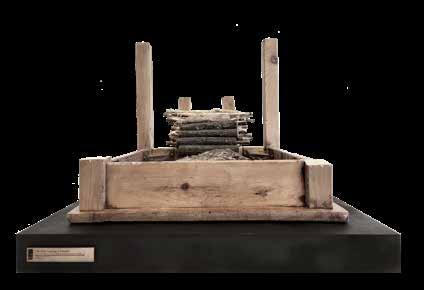

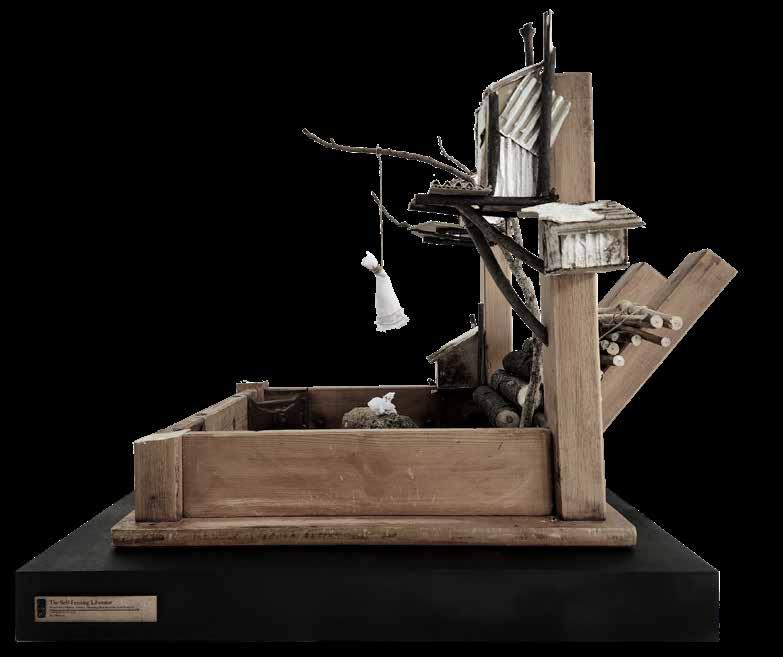
Premise - Engaging the Reality of their Lives 1. 4. 6. 3. 2. 5. 1. 2. 3. 4. 5. 6. Base (Raw) Tools Identifying Material Relationships The First Material The Tale of the Dom Worker’s Moksha The
Model
First
Example of New Drawing Convention
Dissecting Rituals
Rationale and Beliefs of Cremation
Prior to engaging the physical site, the context that should be first explored is the livelihood of the Dom Workers. This covers their daily activities and struggles, the meanings behind their rituals, and the significance of their rituals. By understanding this we will gain the edge over how the general public perceives them and perhaps a strategy to turn the tides of the social position.


1. 2. 3. 4. 1+1=2,1,1,x
The Boiling Rock
The Great Liberator
3. 4.
1
The Coverer’s Corridor
2.
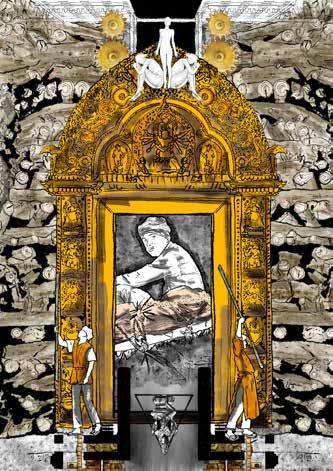
What is Moskha
Ultimate Goal of the Hindu Faith
The responsibility to grant Moksha is a heavy one for no other individual in India is capable of doing so. The Dom Workers are guardians of the sacred flame (5) which is effectively the key to Moksha for it is the beginning of the burning process. No one is able to access the flame apart from the Dom Worker. A significant moment in the cremation is where the Dom Worker crushes the skull (4) of a cremated body, this symbolizes the leaving of a spirit, without which, Moksha is not truly granted. As such the Dom Workers are given an exclusive role as “Gods”, however, this is not the perception of the public. Instead, the Dom Workers are seen as the servants of death. They reek of rotting and burning flesh, and are considered to be dirty. The thesis takes note of this irony, and observes how the Dom Workers deal with the ongoing discrimination. Dom Workers often indulge in alcoholism (2) in order to ensure their sanity due to the constant mental trauma dealing with the realities and uncanniness of death.


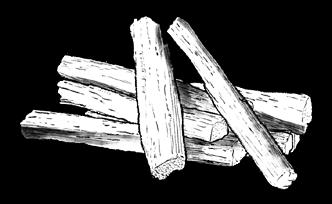





The Sacred flame at the Temple of Shiva
The Ashes and Jewellery that remains
Context - Unveiling & Exposing Rituals
1. 2. 3. 6. 5. 4. 1. 2. 3. 4. 5. 6.
Notes on the meaning of Liberation Drinking to numb the senses Firewood Gesture of cracking the skull


Strength of the Faith
Undying Belief in the Religion
For the last [3] thousand years the faith kept it’s practices going. Even with the rise of technology, Varanasi refuses to dissolve it’s believes. The Electric Columbarium which was introduced in the 2000s is left abandon, we could blame this one religion but we can also link this to the lack of ability to sustain technology (power outage). Hence turning to the existing practice for material based evolution is a key element in the project to ensure it’s build-ability and acceptance.
Context - Unveiling & Exposing Rituals
1.

Study of Site and its Materials
The next step was to break Manikarnika down into it’s material components. The site is houses an elaborate array of texture, each related to the space in a multitude of reasons. A realistic site model was created precisely to capture the materiality of the space and the relationships that follow. The model emphasizes the unevenness and steps (ghats), as well as the informal wood storage spaces that line the site. Not to mention the cremation pyres scattered all around.
1.
2. Manikarnika Site Model 1:100
Manikarnika Site Model 1:100 emphasis on wood pyres
1. Site - Manikarnika Ghats




- Understanding Materiality
Context
2.


Corpse of the Forest of Bliss
Deforestation of Varanasi & India
Varanasi was once known as the “Forest of Bliss”. This was way before the industrial revolution and the economic development along Ganga. Today Varanasi is shredded down to its last 3% of forest cover. A large use of wood is for wood toys, however a larger consumer being the corpse that rely on timber to be burnt. The significance of wood as a burning fuel is due to 2 reason. 1. The symbolism of wood, (mango tree). The Mango tree is known to be a spiritual tree in India, one that embodies meanings of purifying, it being a fuel for cremation transfers its ‘powers’ to the deceased. 2. The Musk of the Dead, rotting bodies are often followed with a stench, the use of wood in the burning process aids to cover it. Especially when using premium wood (sandal wood). Wood that is scented are hence more valuable in the business. Due to the overwhelming popularity of cremation at Varanasi, a large amount of the forest in neighboring states are harvested as well in order to facilitate the heavy demand.

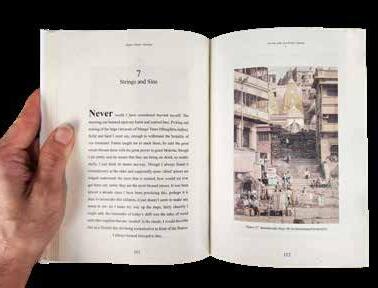



Context - Understanding Materiality
2. 3.
5.
1.
4.
Sketch of Wood Delivery
Chapter on Wood and its influence
Photograph by Adam Colin
Photograph by Andrea de Francis
1.
Photograph by Andrea de Francis
2. 3. 4. 5.

When the Forest is Lost
Exposure to Climate Change
Deforestation is not a crisis that Varanasi faces alone, however, due to its tropical equatorial geolocation, the severe deforestation has left it more vulnerable to the effects of climate change. Report shows that the identified areas lacking tree covers are exposed to severe heat waves and are only sure to be worsened. However, this project acknowledges the significance of wood as a ritualistic material and its un-yielding culture, hence it does not seek to discourage it’s use. Instead, the project questions how the Dom Workers are going to be able to keep up its practices should wood be unable to be produced at a sufficiently fast rate. In understanding these statistics, creating an environment suitable for tree cultivation is not a feasible solution, instead the project focuses on reducing the amount of wood (in weight) used per cremation service in order to reduce its consumption in anticipation of further ritualistic developments.



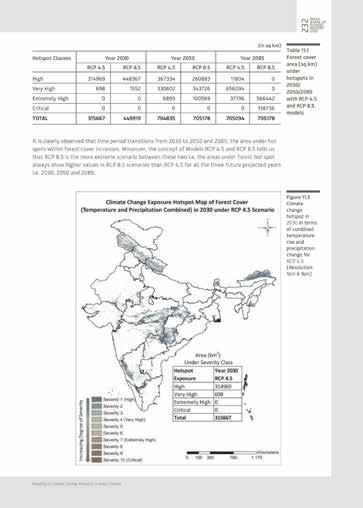



Mapping of Lumber movement by Author
Mapping of Climate Change Hotspots in India Forest by IFSS
Ground Truth Map by IFSS
Tree Cover Statistics by IFSS
Temperature, Humidity and Moisture Content by Samuel. V Glass
Mapping of Climate Change Hotspots by IFSS
Mapping of Climate Change Hotspots by IFSS
2. 6. 7. 3. 4. 5. 1. Context - Understanding Materiality 1. 2. 3. 4. 5. 6. 7.

Unholy River of Ganga
River Ganga’s Pollution Situation
Ganga is amongst the top polluted rivers (4) in the world. Despite its reputation, pilgrims and believers travel each day to be embraced by her, in many cases, to consume (drink) as well (2). The people of India still consider her so pure, her liquid (Gangajal) is amongst the top products to purchase during a visit. Ganga however is as mentioned, in a dire state. She has expired severe abuse since the industrial revolution, where neighboring states along the Gangotri unload waste and chemicals into her, especially the leather industries in Kanpur. Varanasi and the Manikarnika Ghats is no different. Everyday, 100s of corpse are bathed (2) in the Ganga as part of a purification ritual. As such, the spread of disease, bacteria and virus run rampant in the area. The project acknowledges the severity of the pollution crisis and seeks to strictly tackle the pollution that Manikarnika has caused.

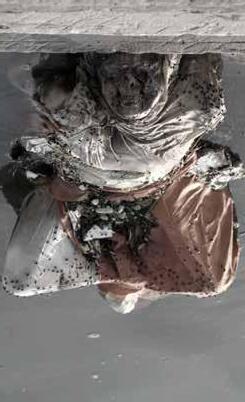




Photographs of Bathing by Wilton-Steer and Corpse in Ganga by Madan Chapter of Paradox of Purity by Author Pollution Assessment of River Ganga
Context - Understanding Materiality
3.
1. 2.
4. The Paradox of Purity by Author
2.
1.
3. 4.

1.
Seasons of Floods & History
Manikarnika is perhaps best understood in time. She embraces the expression of both cyclical, linear and stagnant time. The cyclical aspect of it is best understood with the yearly flood. During the Monsoon season (July - September), the river proceeds to ‘cleanse’ manikarnika from it’s uncanny practices. During the flood, cremation along the ghats are ceased and instead cramped onto rooftops. What is perhaps significant is in fact the post flood. As the water recede, gold and other valuable materials that may have been lost in the ashes of the dead are washed up onto shore and sometimes to doorsteps. Dom Workers celebrate as they hurriedly sift through the silt that surround them after each seasonal flood. This cyclical nature is adjacent to the changes of the space throughout history, just as the forest’s disappearance. This juxtaposition of time and scale is what gave further inspiration to how the ritualistic practices should remain in a cyclical expression of time, however with ever so subtle evolutions that hint at the linearity of life.


2. Flood Risk Areas 1:20,000 (By Author)
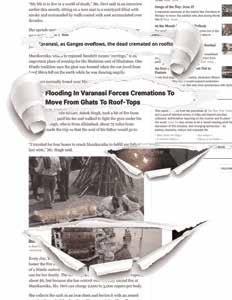
3. NDTV & Prime Asia News Article Abstraction (By Author)

4. Flood Risk (By Mishra, Mallikarjun, Vikas Dugesar, and K.N. Prudhvi Raju)

5. Flood Risk Study (By Mishra, Mallikarjun, Vikas Dugesar, and K.N. Prudhvi Raju)
Context - Understanding Materiality
Mapping of History & Seasons [linear & cyclical time]
A Response to Materials
Considerately, Economically, Ecologically
Given the complexity and significance of the meanings behind the rituals of the Dom Workers and the Hindu faith, the project seeks to respectfully and considerately explore potential ways to professionalize the work of the Dom Workers by rationalizing the design through material means. As such, the practices and minimally altered in their nature, but improved in execution. 1.

 2.
3. 1+1=2,1,1,x
The Tower of Salvation
Existing Cremation Pyre Cage
1.
2.
3.
2.
3. 1+1=2,1,1,x
The Tower of Salvation
Existing Cremation Pyre Cage
1.
2.
3.

The Burning Problem
Uncanniness & Wood Wastage
Burning (1) is perhaps the most significant ritual, the project expands on the evolution of the cremation practice, in hopes of understanding its structural and material needs. It concludes that the form focuses on ensuring that the flame is kept alive for a complete cremation (6). However, as a result, the dignity of treating the bodies is lost. The intervention hence seeks to address the theatrics and performance of the burning process to ensure








Sifting through Ashes for Gold
Chapter on un-professionalism
Chapter on Existing Cremation Pyre Cage
Traditional Burning Pyre (source unknown)
Study on Pyre Cage Structure
Pyre to Pyre Cage Evolution

Proposal - Evolution Through Design
1. 5. 3. 4. 1. 2. 3. 4. 5. 6. 7. Pyre
Photograph by Rohit Bhakar

The Great Liberator
‘Performance’ of Burning
The spirituality of the flame and the symbols of granting liberation is emphasized in the design as it highlights those materials (fire and cloth) involved. A mechanical movement is also introduced to create distance between the corpse and the Dom Workers themselves in hopes for reassociating the Dom Workers with the relevant equipment rather than an emphasis of handling
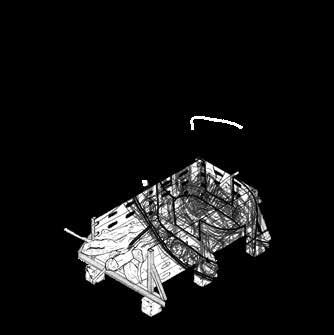

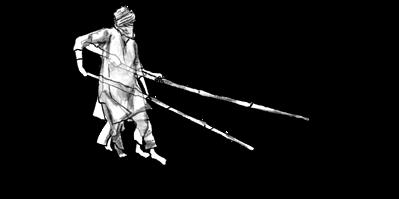




Symbol of Skull cracking after cremation (moksha granted).
The Pyre should self sustain without too much labour.
Study on Thermal Dynamics of the pyre to ensure efficient burning.
The Mechanization of the Dom Worker’s movement.
The aligning of a body of effective burning.
The unprofessional tossing of corpse.
The theatricals of lowering the body into new pyre design.

Proposal - Evolution Through Design
1. 5. 6. 3. 1. 2. 3. 4. 5. 6. 7.



Proposal - Evolution Through Design ELDON NG YEW KEONG A0182451J ISSUE DESCRIPTION STAGE DATE ARCHITECTURAL DESIGN THESIS 2022/2023 TSUTO SAKMOTO STUDIO ASSEMBLAGE NATIONAL UNIVERSITY OF SINGAPORE (NUS) DEPARTMENT OF ARCHITECTURE (DOA) CALL: +65 91198143 DRAWING NUMBER DRAWING PROJECT ALL DIMENSIONS ARE MILLIMETERS UNLESS OTHERWISE STATED. PLEASE READ THIS IN CONJUNCTION WITH ALL OTHER THESE DETAILS SHOWN ARE INTENDED TO CONVEY ONLY THE DESIGN REQUIREMENTS WITH RESPECT TO PROFILES, DIMENSIONS, FINISHES GENERAL ARRANGEMENT OF COMPONENTS; & SHALL NOT CONSTRUED AS ABSOLUTE & ALL INCLUSIVE. NOTWITHSTANDING ANY OMISSION &/OR INADEQUACY THEREOF, THE CONTRACTOR SHALL BE RESPONSIBLE FOR THE DESIGN ENGINEERING, FABRICATION COMPLETE CONSTRUCTION OF THESE COMPONENTS INCLUDING ALL MEASURES NECESSARY TO GUARANTEE FULL COMPLIANCE TO THE DESIGN INTENT, SPECIFICATIONS, PERFORMANCE CRITERIA, WHERE APPLICABLE, TO ALL LOCAL CODES STANDARDS. OWNER OBJECTS ENTITIES MEANINGS [THE TALE OF THE DOM WORKER'S MOKSHA] CALL: +65 91198143 FOR TENDER ONLY TENDER DRAWING 10.04.2023 THE GREAT LIBERATOR PLAN & SECTION A-02-001 F C A E 2 D B 5 1 3 1 5 4 3 2 4 650 125 800 675 1100 650 600 650 600 500 500 500 500 500 150 150 800 1100 250 350 100 F C A E D B A 0.000 650 1,575 2,250 200 200 30 ~2000 ~2000 550 2200 200 200 1300 1000 1300 3600 ~2000MM (L) X ~30MM (D) BAMBOO POLE WIELDED BY DOM WORKER 550MM (D) IRON ROUNDED TEETH GEAR SYSTEM 50MM THICK CYLINDRICAL CATCH FOR BAMBOO 30MM (D) THK POLE CONCRETE FURNANCE IN SMOOTH FINISH HANDMADE BY DOM WORKERS CONCRETE PLINTH STEEL GATE MADE FROM EXISTING CREMATION PYRE 10MM THK STEEL RAIL (50MM DEPTH) SPACE ALLOCATED FOR PYRE & CORPSE SCALE 1:50 THE GREAT LIBERATOR PLAN SCALE 1:50 THE GREAT LIBERATOR SECTION A 1. 2. 3. The Great Liberator Model 1:10 Scale The Great Liberator Plan & Section 1:50 on A3 Interior shot of model featuring gear system that compacts wood during cremation process 1. 2. 3.


Tower of Corpse (trees)
Ineffectiveness of Wood in Varanasi
Wood as suggested is a vital material in the cremation process, despite its importance, the way it is kept/distributed/sold is extremely ineffective and uneconomical. Due to the lack of storage facilities, logs are stacked in an alternating fashion (2) along corridors and the ghats, this formation is an attempt to allow the wood to rest in place, and to hopefully dry. However, given the climatic condition of Varanasi, these logs typically take months or more to dry, which is unideal for burning (dried logs are 30% (5) more efficient for burning). Logs are also sold in an extremely inaccurate manner, using counter weights as a measure (3). The approximate amount of wood used to burn a body is determined by weight as well (roughly 500kgs), this often leads to the incomplete burning of corpse due to the inaccuracy of wood weight due to moisture. Trees that are underage, prior to reach their growth spurt are also inevitably chopped due to the lack of knowledge and overwhelming demand for fuel.
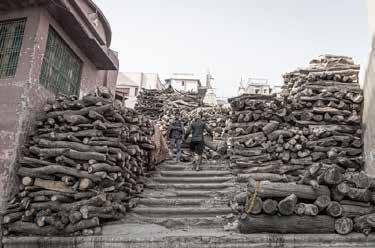


Wood
Wood weighing scale to sell wood
Chapters on Wood, overuse and storage
Study on amount of wood needed per body for cremation
Study on optimal age to harvest wood




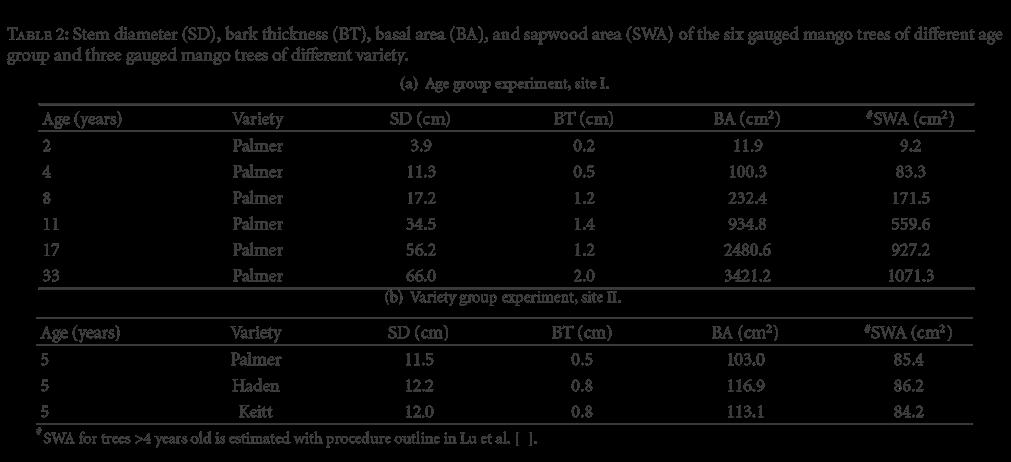
Proposal - Evolution Through Design
1. 2. 3. 4. 5. 6.
2. 3. 4. 5. 6.
1.
Photograph of Wood Storage by Kevinstandphotography
Storage along the streets by Kevinstandphotography


Empowering Wood
Ensuring Quantity and Quality
Focusing on the effectiveness of Wood as a fuel, the project studies the optimal condition for wood to be dried, and optimal age for wood to be harvested. These are done in hopes to affirm both the quality and quantity of wood used in each cremation, doing so allows the Dom Workers to create a more systematic economy that does not fluctuate due to over selling (wastage) of supply. The first concept of drying is carried out through the observation of technological advancements created to speed up the drying process. The solar kiln(5) as a precedent suggest using consistent airflow as a means of drying. The project however acknowledges the lack of advance materials, and seeks to use convection currents created by the heat of ashes (4) as a means to create consistent airflow. The project also conducted a study on the growth spurt of mango trees to ensure that the Dom Workers are able to acquire them at the economically optimal age, only about 28 logs (7) are need as 30% is saved due to an increased in burning efficiency (2) through drying.
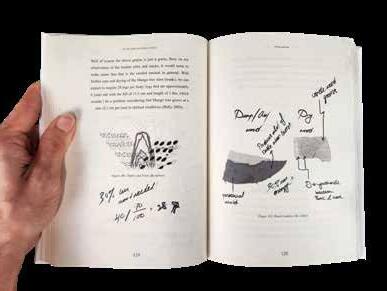





Proposal - Evolution Through Design
2. 3. 4. 6.
2. 3. 4.
6. 7. Hanging
1. 1.
5.
in Balance by Author Chapter on Wood Drying and Pores
Wood Carving Equipment Sketch for Wood Drying Proposal Solar Kiln as Model for Wood Drying
Wood Carving to increase drying speed
Bundles of wood, 28 per corpse for burning

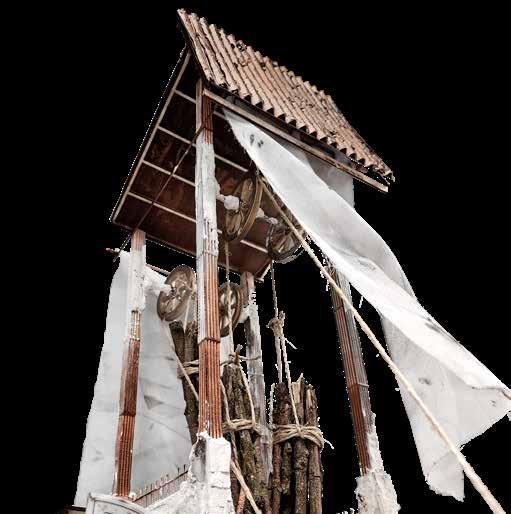


Proposal - Evolution Through Design 1. 2. 3. 4. 1:20 Scale Model emphasis on Roof Pulley System Tower of Salvation Section Drawing and Transport Details 1:20 Scale Model Elevation 1:20 Scale Model emphasis on Tree Bundles ELDON NG YEW KEONG A0182451J ISSUE DESCRIPTION STAGE DATE TSUTO SAKMOTO STUDIO ASSEMBLAGE NATIONAL UNIVERSITY SINGAPORE (NUS) DRAWING NUMBER DRAWING PROJECT REPRODUCED WITHOUT PERMISSION FROM FARM. DIMENSIONS, FINISHES GENERAL ARRANGEMENT COMPONENTS; SHALL NOT CONSTRUED AS ABSOLUTE ALL INCLUSIVE. NOTWITHSTANDING ANY OMISSION &/OR INADEQUACY THEREOF, THE CONTRACTOR SHALL BE COMPLIANCE TO THE DESIGN INTENT, SPECIFICATIONS, PERFORMANCE CRITERIA, WHERE APPLICABLE, ALL LOCAL OWNER OBJECTS ENTITIES MEANINGS [THE TALE THE DOM WORKER'S MOKSHA] FOR TENDER ONLY TOWER OF LIBERATION SECTION SECONDARY DETAILS A-03-002ISOMETRIC OF EXISTING BICYCLE SCALE 1:50 TOWER OF SALVATION SECTION B 350 1965 715 1370 1500 500 500 545 1016 3200 220 2030 700 130 900 1800ISOMETRIC OF WOOD BUNDLE (PER PAX) APPROXIMATELY 500 KG(S) WHICH IS THE MINIMUM AMOUNT OF WOOD TO BURN AN ADULT SIZED BODY COMPLETELY BICYCLE THAT IS AVAILABLE ON SITE WITH CARRIAGE ATTACHED TO BACK [DESIGN MAY VARY SLIGHTLY BETWEEN BICYCLES DUE TO PERSONAL MODIFICATIONS] WOOD SHAVING PLATFORM. SOLID WOOD PLATFORM 28 PIECES OF TIMBER LOGS AGE APPROX YEARS OLD 150MM (D) 100 1000 100 EQ EQ 2. 1. 3. 4.

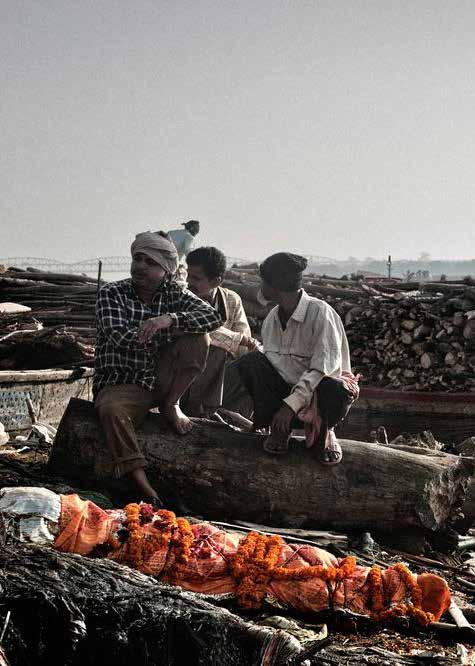
Covering Corpse in Bliss
Hiding/Preserving Death
Orange represents the sun. The Sun is the indicator of Moksha in the hindu culture and hence it is often the choice of colour to dress the deceased in. Apart from the auspicious colour, the covering of the corpse serves a significant practical purpose. The first and naturally so, is to hide the uncanniness of death (2). As there are many who have passed outside of Varanasi, their bodies takes over a day to be transported(3) to the Manikarnika, given India’s hot and humid climate(6), the bodies would undergo severe rotting at an exponential rate, the cloth protects the living from these realities. In a similar chain of thought, the next reason is scent, as the body rots, it produces the stench and is beyond revolting, covering the body reduces the exposure of the natural elements, but also reduces the spreading of smell to the surroundings, this is often aided by covering the body with flowers and other auspicious vegetation. In all the cloth not only acts as a symbol of bliss, but as a barrier that protects the living from the realities of death.
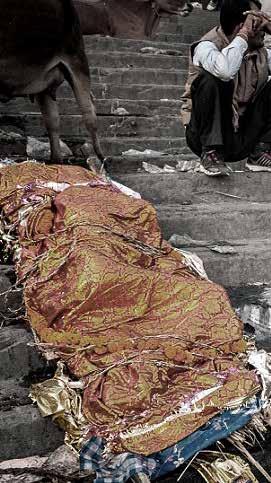


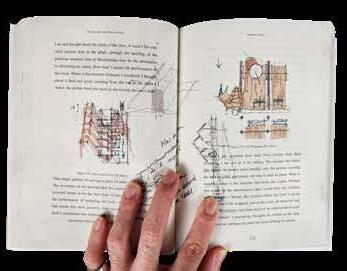

Proposal - Evolution Through Design
1. 2. 3. 4. 5. 6. 1. 2. 3. 4. 5. 6.
by
Photograph
Andrea de Francis “Awaiting” Photograph by Michael Huniewicz
“Last Mile” Photograph by Parag Shinde
Registry of people waiting to die by Parag Shinde
Chapter on Cloth and its movement by Author
Streets selling Cloth and other materials by Author
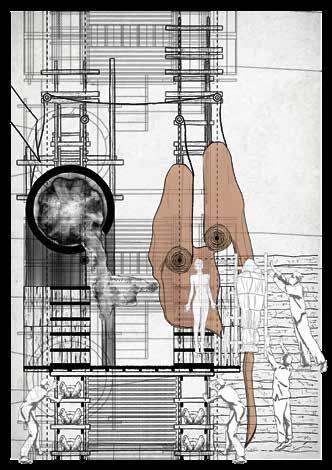
Wrapping and Storing
Structure in response to rituals



Covering the corpse takes place just before laying it over a bamboo stretcher for the grievers to shoulder down to the river. The structure size is hence determined by the anthropometry of the human body(2), and the standardization of the bamboo stretcher(4). The structure facilitates the process of wrapping, but the construction of the stretchers in a uniform manner(2). It takes advantage of the malleability of the orange cloth(3) and uses it as a facade treatment that also protects the identity of the Dom Workers through creating a semi-ambiguous working environment. Hoisted above the ground, the structure also respects the deceased by ensuring it does not touch the ground and can be immediately placed on the shoulders(5) of grievers once the wrapping is done. The potential lack of wood for burning anticipates long queues that could possibly take days in wait of the materials for burning. A storage facility is included below for bodies to be kept, ashes is also used as a drying agent to reduce humidity levels to slow the process of decay.


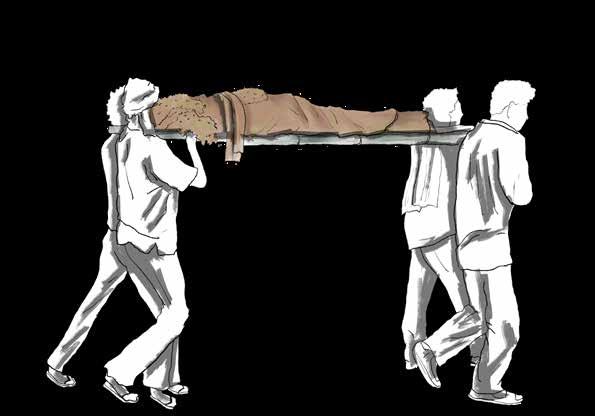
Proposal - Evolution Through Design
1. 2. 3. 5. 4. 1. 2. 3. 4. 5. Behind the Curtains by Author Section Cut Sketch of Coverer’s Corridor Cloth and Flowers (marigold) Bamboo Stretcher Shouldering the corpse to the river

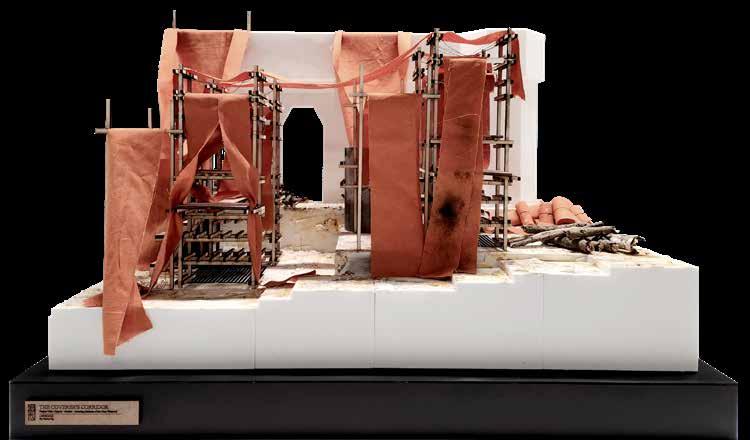

Proposal - Evolution Through Design SCALE 1:100 COVERER'S CORRIDOR SECTION A ELDON NG YEW KEONG A0182451J ISSUE DESCRIPTION STAGE DATE NATIONAL UNIVERSITY OF SINGAPORE (NUS) DEPARTMENT ARCHITECTURE (DOA) DRAWING NUMBER DRAWING PROJECT STATED. PLEASE READ THIS CONJUNCTION WITH ALL OTHER RELEVANT DRAWINGS. COPYRIGHT THIS DESIGN DRAWING DESIGN REQUIREMENTS WITH RESPECT TO PROFILES, DIMENSIONS, FINISHES GENERAL ARRANGEMENT OF INADEQUACY THEREOF, THE CONTRACTOR SHALL RESPONSIBLE FOR THE DESIGN ENGINEERING, FABRICATION INCLUDING ALL MEASURES NECESSARY TO GUARANTEE FULL COMPLIANCE TO THE DESIGN INTENT, SPECIFICATIONS, OWNER OBJECTS ENTITIES MEANINGS CALL: +65 91198143 FOR TENDER ONLY COVERER'S CORRIDOR DETAILS A-05-001 -1,000 0.000 1,000 2,400 6,300 8,000 0.000 A B C D E F G H J K L BAMBOO STRETCHER MAKING SPACE BAMBOO STRETCHER MAKING SPACE BODY STORAGE SPACE ASH HUMIDITY CONTROLLER CLOTH/CANVAS FABRIC ROOF CYLINDRICAL OPEN AIR ASH HOLDING POINT MADE OF SLIT AND STONE TIMBER STRUCTURE IS MADE USING 50MM X 100MM RECTANGLE SECTION TIMBER PLANKS TIMBER FLOORING IS MADE USING 20MM THICK TIMBER PLANKS 500 500MM WIDTH TIMBER BRIDGE 1000 1000 1400 3900 1700 1445 1620 1000 1620 1000 1620 1000 1620 1000 1620 1445 15000 9000 1. 2. 3. The Coverer’s Corridor Section A 1:100 on A3 The Coverer’s Corridor 1:20 Scale Model Elevation The Coverer’s Corridor 1:20 Scale Model Emphasis on Workshop 2. 3. 1.

Bacteria Pollution Ganga
Bathing of Corpse in Ganga
Ganga is victim to severe pollution since the industrial revolution and the project seeks to address the bacteria and disease pollution that is created as a result of washing rotting corpse in her (8). The project seeks to identify moments (3) in which Ganga can be purified, to which, it finds opportunity in the yearly flood. The project also studies ways in which bacteria and viruses can be killed, and the decided solution was through extremely high temperatures (boiling). The design explores the potential methods (2) in which water can be boiled without the presence of electricity (4), and identifies stone boiling as a unique way of instantaneously boiling smaller amounts of water and creating a mist effect (4). After further observation of the site, the project discovers an opportunity to allow Stone boiling by proposing the use of the Large Stone blocks that are found on site (7); originally for weighing down non-burnable corpse (due to religious reasons). The project also employs ancient stone henge technology to allow the rock to be easily maneuvered (6).








Photograph by Wilton-Steer
Study on Stone Blocks on Site
Study on bathing corpse
Study on water boiling, fire and stone boiling
Study on Corpse dimensions
Study on Rock Rolling from Stone Henge technology
Large Stone Blocks on Site
Ganga Pollution by Pollution Assessment
Proposal - Evolution Through Design 2. 3. 8. 7. 4.
1. 1. 2. 3. 4. 5. 6. 7. 8.


Secluding & Purifying Alleviating Pollution in Ganga
The Design cleanses water in a few methods. First by creating a separate water body for washing bodies, this is done by creating a well system that catches retains river water after the yearly monsoon. The water within the well can be manually extracted into an anthropometrically sized pool (5)that is used to wash the corpse, this very water can be purified and rid of bacteria instantly by rolling a boiling hot stone across its surface, instantaneously perishing them. The stone is heated 24/7 by conducting the heat from cremation pyres that are also unending. Once each corpse has taken a dip, the stone can be rolled over to clean the water for the next user. The remaining water within the well is also continuously boiled by conducting heat from a fellow cremation pyre, the boiling process ensures that the water is not stale. Water Vapour as a result of the boiling is condensed by a bamboo roof (4) above, that distills water into bottles that can then be sold at a higher price than original Gangajal(2). The well can also be manually filled using the access ladder(6).



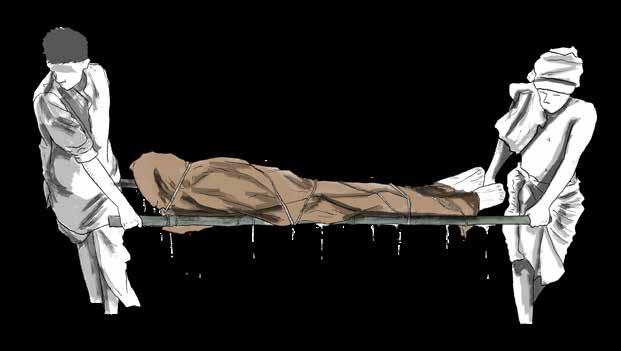
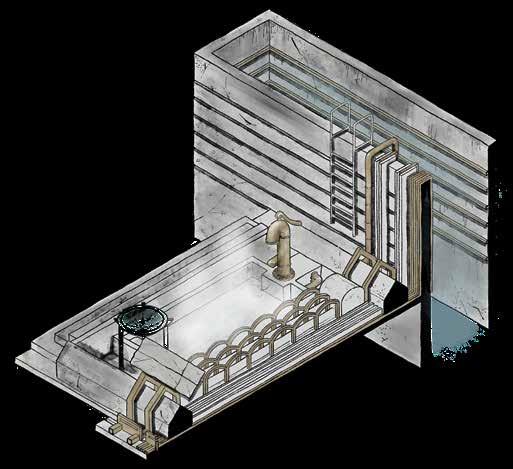
Proposal - Evolution Through Design
1.
1. 2. 3. 4. 5. 6. Conduction & Conductor by Author
from Desertcart.sg The Basin of New Ganga Bamboo Roof Distillation System
the Corpse Isometric
Boiling Rock
2. 3. 5.
Image
Anthropometry of Bathing
Drawing of The



Proposal - Evolution Through Design 1. 2. 3. The Boiling Rock 1:20 Scale Model Elevation The Boiling Rock Floor Plan and Section The Boiling Rock Manual Pump and Bamboo Roof System ELDON NG YEW KEONG A0182451J ISSUE STAGE NATIONAL UNIVERSITY SINGAPORE (NUS) DEPARTMENT OF ARCHITECTURE (DOA) CALL: +65 91198143 DRAWING NUMBER DRAWING PROJECT RELEVANT DRAWINGS. COPYRIGHT OF THIS DESIGN DRAWING REPRODUCED WITHOUT PERMISSION FROM FARM. DESIGN REQUIREMENTS WITH RESPECT TO PROFILES, DIMENSIONS, FINISHES GENERAL ARRANGEMENT OF COMPONENTS; SHALL NOT CONSTRUED AS ABSOLUTE ALL INCLUSIVE. NOTWITHSTANDING ANY OMISSION &/OR RESPONSIBLE FOR THE DESIGN ENGINEERING, FABRICATION COMPLETE CONSTRUCTION OF THESE COMPONENTS COMPLIANCE TO THE DESIGN INTENT, SPECIFICATIONS, PERFORMANCE CRITERIA, WHERE APPLICABLE, TO ALL LOCAL OWNER OBJECTS ENTITIES MEANINGS CALL: +65 91198143 FOR TENDER ONLY THE BOILING ROCK SITE PLAN SECTION A A-06-001 1 2 3 4 5 6 7 8 9 SCALE 1:100 THE BOILING ROCK SITE PLAN SCALE 1:100 THE BOILING ROCK SECTION A A 3,250 1,000 0.000 1000 2250 650 6110 1700 200 3450 6110 1700 3500 2300 1700 1735 5735 3200 3200 A 1 2 3 4 5 6 7 8 9 B D E F C B C 3,850 50MM X 50MM SHS COPPER BAR TO CONDUCT HEAT ENERGY FROM PYRE TO WATER TANK (5MM THICK) BAMBOO ROOF SYSTEM WITH DEGREE INCLINE WATER BOTTLE COLLECTING RESIDUE CONDENSED (PURIFIED) WATER MANUAL HAND LEVER PUMP 50MM X 50MM SHS CONDUCTING COPPER (5MM THICK) CURVED SHS FOR STONE TO ROLL APPROX 20KG OR MORE, STONE FROM SITE CONDENSATION BASIN 1. 3. 2.
20 Sided Commandments
Tension between Allegory & Architecture
The Project believes that the expression of rituals and beliefs can be integrated into a form of architectural language, however it does also acknowledge the realities of built projects and the necessity for ‘formal’ drawings. Here lies a series of 20 drawings, each pair in tension between allegorical architectural expression, and formal architectural drawings. To which I believe, should be read as a set of instructions that command the relationship between ritual and material properties rather than mere standardization of form.


Proposal - Instructions for Translation


Assemblage of Relationships
A potential Master Planning Tool
Despite each intervention being relative humanistic in scale, they were never envisioned to be singular exclusive structures that tackle individual components of the rituals. They are instead immediate manifestation (5) of the relationship between material (3) and rituals (2), however they are conceptualized to be malleable and in constant communication (1) with the surrounding materials and adjacent rituals. The Architectural devices are hence best understood as pawn pieces that are capable of transforming once it has crossed the board, allowing it to go beyond its limitations.

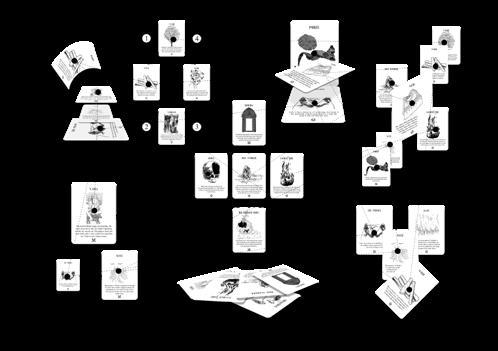


Proposal - Instructions for Translation
1. 2. 5. 6. 4. 3. 1. 1. 2. 3. 4. 5. 6. Assemblage of Cards Assemblage of Rituals Cross Relationships ELDON NG YEW KEONG A0182451J ISSUE DESCRIPTION STAGE DATE NATIONAL UNIVERSITY OF SINGAPORE (NUS) DEPARTMENT OF ARCHITECTURE (DOA) DRAWING NUMBER DRAWING PROJECT ALL DIMENSIONS ARE IN MILLIMETERS UNLESS OTHERWISE THESE DETAILS SHOWN ARE INTENDED CONVEY ONLY THE COMPONENTS; SHALL NOT CONSTRUED AS ABSOLUTE ALL INCLUSIVE. NOTWITHSTANDING ANY OMISSION &/OR INADEQUACY THEREOF, THE CONTRACTOR SHALL BE COMPLIANCE TO THE DESIGN INTENT, SPECIFICATIONS, PERFORMANCE CRITERIA, WHERE APPLICABLE, ALL LOCAL OWNER OBJECTS ENTITIES MEANINGS [THE TALE THE DOM WORKER'S MOKSHA] FOR TENDER ONLY THE ASSEMBLAGE DETAILS A-07-002 3 A B C D E F G H I J K CORRUGATED ZINC SHEET ROOF RE-ENFORCED STEEL RODS COVERED BY PLASTER/SILT ON SITE 28 PIECES OF TIMBER LOGS AGE APPROX YEARS OLD 150MM (D) FABRIC FACADE TO PROTECT TIMBER FROM DIRECT SUNLIGHT X 25MM (D) IRON ROD WOOD SHAVING PLATFORM. SOLID WOOD PLATFORM FABRIC FACADE WITH 'STORE' NUMBER IRON WHEEL PULLEY SYSTEM A B C D E F G H I J K 2530 2030 2700 2000 650 2000 500 800 1875 8450 4400 1300 1200 1700 0.000 4,400 5,700 6,900 8,600 SCALE 1:100 THE ASSEMBLAGE SECTION A WHEEL BARROW FOR TRANSFER OF TIMBER LOG, CONNECTOR TO BE MADE OF STEEL ROD FRAME FOR ASHES TO BE THROWN DOWN GANGAJAL SELLING POINT WOOD SHIPMENT RECEIVING POINT CORPSE WASHING SPACE RE-ENFORCED ROD TO ANCHOR BOATS IRON WHEEL PULLEY SYSTEM Master Plan 01 The Manifestation on site The Assemblage Section A 1:100

A Series of Parts
Deconstruction of Relationships
The Final drawing (2) of the project further ties back to Katherine Hayles Theory of Assemblage. It suggest an infinite number of relationships that could be formed with our understanding of the materiality and rituals of Manikarnika and the Dom Workers. Katherine suggests that the assemblage always gives rise to an “emergent property”, to which the drawing (2) tries to express that the eventual Architectural Manifestation should be an ‘emergent’ property that arises out of the interaction between components of the rituals and their materials. The project hopes to suggest that any architectural intervention that may be found on this sacred site should not be one that is proposed by the mere human mind, but rather evolved from objects, entities, and their meanings.

The Assemblage of Parts

Proposal - Instructions for Translation
1. 2. 1. 2. 1+1=2,1,1,x













 2. Orange Cloth Drapped Over Corpse
3. Washing the Corpse in River Ganga
4. Cremating the Corpse
2. Orange Cloth Drapped Over Corpse
3. Washing the Corpse in River Ganga
4. Cremating the Corpse































































































































































